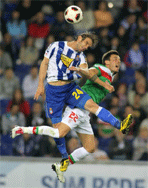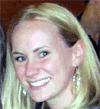
Concussions (or mild traumatic brain injuries) have received
considerable press due to the high prevalence in sport and
the potential for long-term and often disabling symptoms. A
concussion may occur when there is a direct impact either to
the head or with a blow elsewhere in the body with forces
that are transmitted to the head. The acute symptoms of a
concussion are generally not the result of pathological or
structural changes, and thus no abnormalities are seen on
radiographs or other imaging (4). Instead, symptoms are due
to microscopic axonal injury and a resultant “neurometabolic
cascade” occurring within the brain (3). The normal ionic
balance and energy metabolism are disrupted and the brain
then requires increased energy to return to its normal
state. Unfortunately, there is decreased cerebral blood flow
and mitochondrial dysfunction post-injury, so less glucose
is available in the brain (3). This energy supply-and-demand
mismatch can cause concussion symptoms.
Concussion symptoms vary based on the patient and a list of
common symptoms is found in the box below. Headaches are the
most frequently reported symptom, followed by dizziness (3).
The vast majority of concussions will resolve quickly, with
80-90% of patients experiencing symptom resolution after
seven days (3). There is some concern that cognitive
deficits may persist even after symptom resolution, which
has been shown with neurophysiological testing. Further
research continues to be done in this area to assure full
resolution of symptoms prior to return to activity (3).
| Symptoms and
Symptoms of a Concussion (3) |
¨
Physical
- Headache
- Nausea
- Vomiting
- Balance problems
- Dizziness
- Visual problems
- Fatigue
- Sensitivity to light
- Sensitivty to noise
- Numbess/tingling
- Dazed
- Stunned |
¨ Cognitive
- Feeling mentally "Foggy"
- Feeling slowed down
- Difficulty concentrating
- Difficulty remembering
- Forgetful of recent information and conversations
- Confused about recent events
- Answers questions slowly
- Repeats questions |
¨ Emotional
- Irritable
- Sadness
- More emotional
- Nervousness |
¨ Sleep
- Drowsiness
- Sleep more than usual
- Sleep less than usual
- Difficulty falling asleep |
Following a concussion, patients are prescribed rest from
physically and cognitively fatiguing activities to allow the
brain to recover (4). In addition to resting from sports,
patients are often held out of full school or work days and
have other restrictions, including no taking notes, reading
or testing, nor use of computers, cell phones or television.
They may also be encouraged to avoid bright or noisy
environments. Excessive activity, either physical or
cognitive, increased the energy demand upon the brain and
may lead to prolonged symptoms. Patients are also cautioned
against the return to any activities that have the potential
to cause further trauma to the brain. Until the brain fully
recovers from the initial injury, it is more vulnerable to
re-injury. The second injury is usually more severe, and in
the case of second-impact syndrome, may lead to permanent
deficits or even sudden death (2). Recurrent injuries may
lead to long term cognitive deficits, as in chronic
traumatic encephalopathy (CTE), though further research
needs to be done to determine if there is a true
cause-and-effect (4).
Prior to participating in contact sports, athletes should
undergo preseason baseline concussion testing (2). These may
include tests like the SCAT-3, NFL Sideline Concussion
Assesment Tool, or the computerized ImPACT testing, as well
as a balance test, such as the Balance Error Scoring System
(BESS) Test. Tests are repeated following a suspected
concussion and pre- and post-injury scores are compared.
This allows health care professionals to compare pre- and
post-injury status for the presence of concussion and later
for return-to-play decisions (2). Copies of concussion
assessment tools are below:
·
SCAT 3
·
NFL Sideline Concussion Tool
·
BESS Test
Patients should be held from physical activity until they
return to their pre-injury status to prevent the risk of a
catastrophic event. Once a patient is deemed to be
symptom-free by a physician, athletic trainer or physical
therapist or other health care provider, they may begin a
gradual return to activity. With a typical concussion that
resolves quickly, the patient may progress through the
return to play (RTP) protocol with one day at each stage,
pending no increase in symptoms during or after (4). An
athletic trainer or physical therapist is often helpful in
safely progressing through the RTP protocol. If any
concussion symptoms increase, the patient needs to rest
until symptoms resolve, then take a step back and repeat the
previous stage before continuing the RTP protocol (3).
Patients who experienced persistent or severe
post-concussive symptoms are often progressed more slowly,
spending multiple days at each level. Patients with a
history of previous concussions or those with more complex
recoveries will likely require physician release for return
to contact activity.
| Graduated
Return to Play Protocol (4) |
| Rehabilitation
|
Functional
exercise at each stage of rehabilitation |
Objective of each stage |
| 1) No activity |
Symptom
limited physical and cognitive test |
Recovery |
| 2) Light
aerobic activity |
Walking,
swimming or stationary cycling keeping intensity
<70% maximum permitted heart rate. |
Increase HR |
| 3)
Sport-specific exercise |
Skating
drills in ice hockey, running drills in soccer. No
head impact activities. |
Add movement |
| 4)
Non-contact training drills |
Progression to more complex training drills. eg.
passing drills in football and ice hockey. May start
resistance training. |
Exercise, coordination and
cognitive load |
| 5)
Full-contact practice |
Following medical clearance participation in normal
training activities. |
Restore confidence and assess
functional skills |
| 6)
Return to play |
Normal
game play. |
|
Approximately 10-15% of those sustaining a concussion will
still experience symptoms after ten days (3). Risk factors
for persistent symptoms include (2):
- History of previous concussion(s)
- Greater number of symptoms or increased severity of
initial symptoms
- Female gender
o May be due to the relationship between estrogen & cerebral
blood flow or
due to decrease
head-neck mass
- Younger age
o Due to lack of development of the brain
- History of depression, anxiety, irritability, learning
disabilities, ADD/ADHD
- History of migraines or other headaches
Typically, a physician and/or an athletic trainer manage
concussions, though patients with long-lasting concussive
symptoms may benefit from referral to other health care
professionals. Physical therapists may assist with physical
symptoms, while a neuropsychologist is able to assess and
treat cognitive and emotional symptoms that persist.
Physical therapists can play a vital role in the treatment
of post-concussive syndrome and are often under-utilized.
Physical symptoms may persist weeks after the initial injury
and severely impact daily function. Headaches due to head
trauma may have a cervicogenic component, much like
whiplash. Addressing cervicothoracic mobility and soft
tissue restrictions can often provide relief. In addition,
strengthening deep cervical flexors and scapular stabilizers
can also assist in improved scapulothoracic and cervical
stability and decrease in headaches.
In addition, patients with post-concussive syndrome may have
persistent dizziness, blurry vision, or balance deficits
that may benefit from physical therapy (1). They may note
difficulty walking through the hallway at school, riding in
a car, with a change in head position, reading, or taking
notes in class. A physical therapist experienced in
vestibular rehabilitation can provide exercises to address
ocular mobility, gait, and balance to allow for improved
daily function (1).
Given the complexity of concussions and the variability of
recovery, patients will often benefit from a team of health
care providers to allow for the most efficient and thorough
recovery. This team may include the physician, athletic
trainer, physical therapist and neuropsychologist, in
addition to the athlete, and possibly family. Though knowledge about concussions has
increased dramatically in the recent past, continued
research needs to be done. In addition to determining the
most appropriate way to identify and treat an individual
suffering symptoms from a concussion, we need to further our
knowledge in preventing these injuries.
Click here to continue to "The Role of the Physical
Therapist When Working With Patients With Post-Concussive
Syndrome - (Part 2)"
Last revised: March 18, 2013
by Lauren Hogan, PT, DPT, ATC
References
1) Alsalaheen, B. A., Mucha, A., Morris, L. O., Whitney, S.
L., Furman, J. M., Camiolo-Reddy, C. E., Collins, M. W., et
al. (2010). Vestibular rehabilitation for dizziness and
balance disorders after concussion. Journal of neurologic
physical therapy : JNPT, 34(2), 87–93.
doi:10.1097/NPT.0b013e3181dde568
2) Guskiewicz, K. M., Bruce, S. L., Cantu, R. C., Michael,
S., Kelly, J. P., Mccrea, M., Putukian, M., et al. (2004).
National Athletic Trainers’ Association Position Statement:
Management of Sport-Related Concussion, 39(3), 280–297.
3) Harmon, K. G., Drezner, J. A., Gammons, M., Guskiewicz,
K. M., Halstead, M., Herring, S. A., Kutcher, J. S., et al.
(2013). American Medical Society for Sports Medicine
position statement: concussion in sport. British Journal of
Sports Medicine , 47 (1 ), 15–26.
doi:10.1136/bjsports-2012-091941
4) McCrory, P., Meeuwisse, W. H., Aubry, M., Cantu, B.,
Dvorak, J., Echemendia, R. J., Engebretsen, L., et al.
(2013). Consensus statement on concussion in sport: the 4th
International Conference on Concussion in Sport held in
Zurich, November 2012. British Journal of Sports Medicine,
47(5), 250–258. doi:10.1136/bjsports-2013-092313
|







